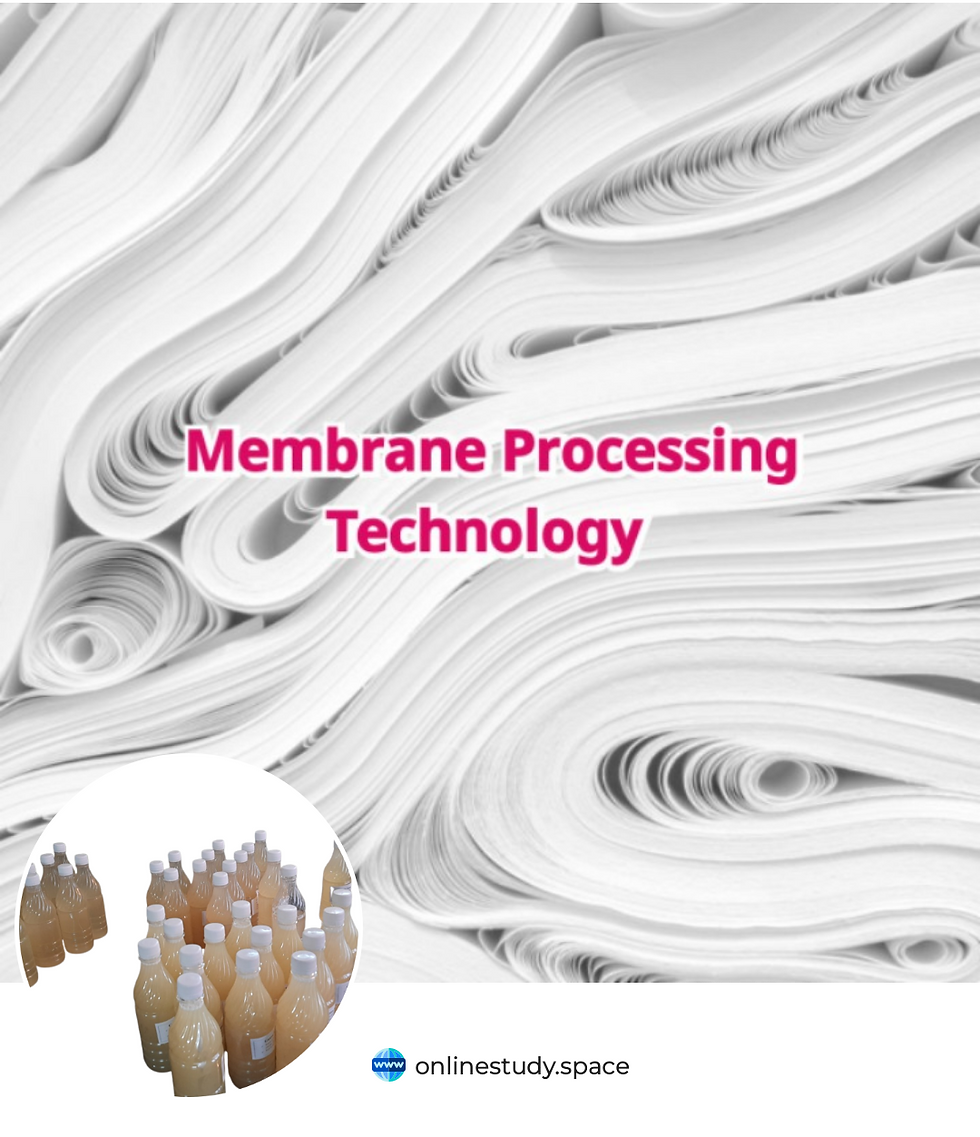Membrane Processing Technology
- Prof. Bhagwan Deen

- Nov 27, 2024
- 3 min read

Membrane processing technology is a fascinating field that involves the use of semi-permeable membranes to separate substances based on their size, shape, or chemical properties. Here are some key aspects of membrane processing technology:
Principles of Membrane Processing Technology
Selective Permeability
Membranes are designed to allow certain molecules or ions to pass through while blocking others. This selectivity is based on factors like size, charge, and chemical affinity.
Driving Force
The movement of substances through the membrane is driven by a gradient, such as pressure, concentration, or electrical potential. Common driving forces include:
Pressure Gradient: Used in processes like reverse osmosis and ultrafiltration.
Concentration Gradient: Utilized in dialysis and pervaporation.
Electrical Potential Gradient: Applied in electrodialysis.
Membrane Structure
Membranes can be classified based on their structure:
Porous Membranes: Have small pores that allow selective passage of molecules based on size (e.g., microfiltration and ultrafiltration).
Non-Porous Membranes: Rely on diffusion through the membrane material itself (e.g., reverse osmosis and gas separation).
Membrane Materials
Membranes are made from various materials, each with specific properties:
Polymeric Membranes: Made from synthetic polymers like polyamide, polysulfone, and polyvinylidene fluoride (PVDF).
Ceramic Membranes: Made from inorganic materials like alumina and zirconia, known for their durability and chemical resistance.
Composite Membranes: Combine different materials to enhance performance and selectivity.
Membrane Configuration
The design and arrangement of membranes in a system can vary:
Flat Sheet Membranes: Used in plate-and-frame modules.
Hollow Fiber Membranes: Consist of thin, hollow fibers bundled together, providing a high surface area.
Spiral Wound Membranes: Comprise flat sheets rolled into a spiral, commonly used in reverse osmosis.
Transport Mechanisms
The movement of substances through membranes can occur via different mechanisms:
Diffusion: Movement of molecules from high to low concentration.
Convection: Movement driven by pressure differences.
Electromigration: Movement of charged particles under an electric field.
Types of Membrane Processes
Microfiltration (MF)
This process removes particles and microorganisms from liquids. It is commonly used in the food and beverage industry, as well as in water treatment.
Ultrafiltration (UF)
UF membranes have smaller pores than MF membranes and can remove viruses, proteins, and other macromolecules. It is widely used in the dairy industry for milk and whey processing.
Nanofiltration (NF)
NF membranes have even smaller pores and can remove divalent ions, making them suitable for water softening and desalination.
Reverse Osmosis (RO)
RO membranes have the smallest pores and can remove almost all dissolved salts and impurities from water. It is commonly used for desalination and producing high-purity water.
Applications of Membrane Technology
Water Treatment
Membrane technology is extensively used for water purification, including desalination, wastewater treatment, and drinking water production.
Food and Beverage Industry
Membranes are used for processes like milk concentration, juice clarification, and beer filtration.
Pharmaceuticals and Biotechnology
Membrane processes are used for the separation and purification of drugs, proteins, and other biological molecules.
Chemical Processing
Membranes are used for separating and purifying chemicals, gases, and solvents.
Advantages of Membrane Technology
Energy Efficiency
Membrane processes typically require less energy compared to traditional thermal separation methods like distillation.
Scalability
Membrane systems can be easily scaled up or down to meet different production needs.
Environmental Impact
Membrane processes generate fewer secondary pollutants and are considered more environmentally friendly.
Challenges and Future Prospects
Fouling: Membrane fouling, caused by the accumulation of particles on the membrane surface, can reduce efficiency and lifespan.
Material Development: Research is ongoing to develop more durable and efficient membrane materials, including biodegradable and eco-friendly options.
Innovative Applications: Future advancements may include the use of membranes in new areas such as carbon capture, energy storage, and advanced medical treatments.



Comments